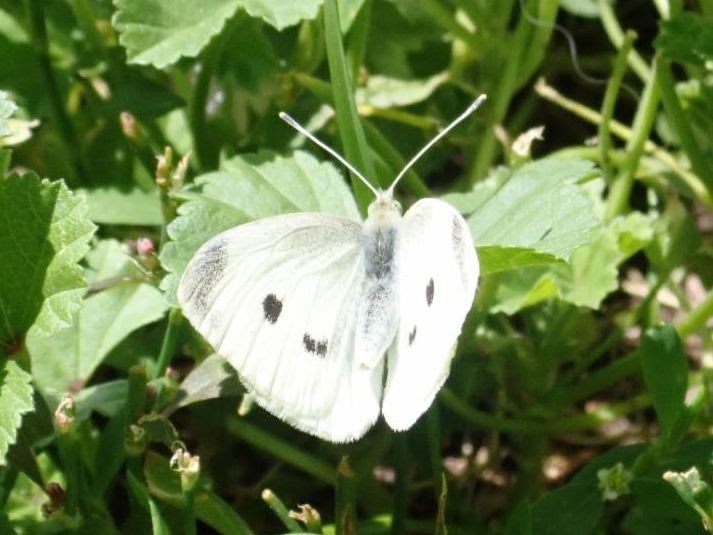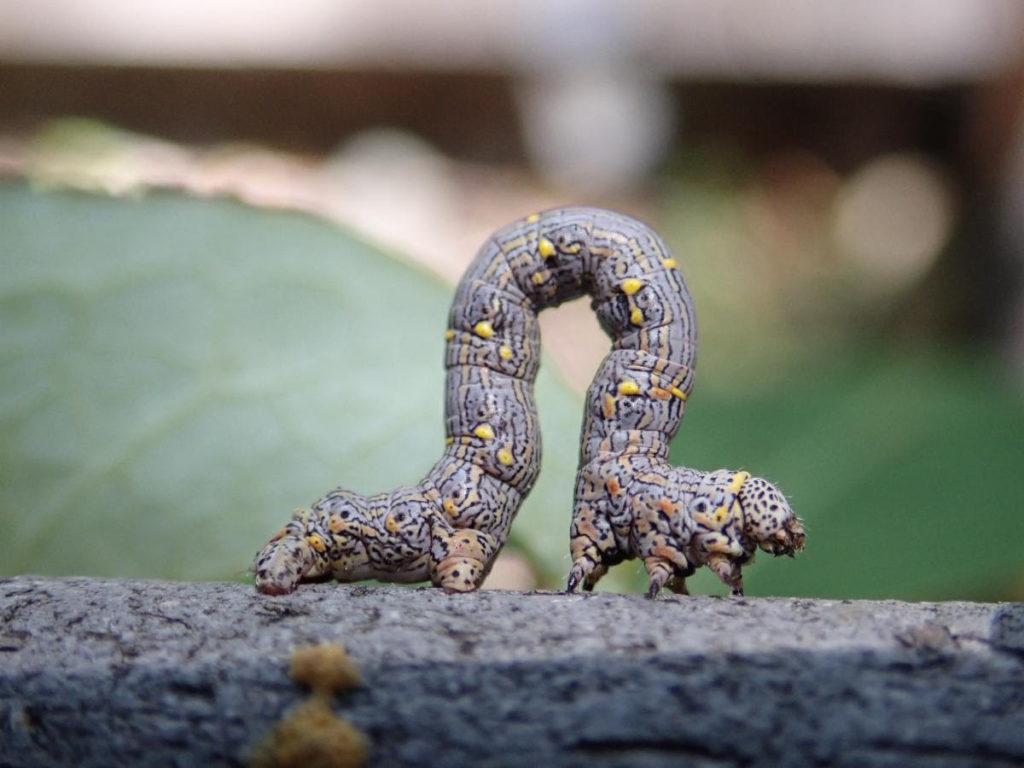Did you pack your sunscreen? The days are long, the sun is fierce, and if you’re not careful, you might end up with a sunburn trying to capture a photo of one of the innumerable insects flitting about (we speak from experience). Even resting in the shade provides ample opportunity for bug sightings, as some prefer to escape the heat of the day while others thrive in the sun. Try taking in the scenery for a few moments; you never know who might come and join you.

Alfalfa Looper
Autographa californica
Unlike most moths, Alfalfa Loopers are active both day and night. You may see them visiting flowers during the day or fluttering to lights at night. They range throughout the west, from as far north as Alaska and south to northern Mexico. Caterpillars feed on a wide variety of plants. They particularly like alfalfa and peas; this individual was found near a pea plant, where it was spotted in its larval form earlier this spring.
Brenna Shea, July 4th, 2023. Missoula, MT.
Leafy Spurge Hawkmoth
Hyles euphorbiae
During a bug hunt one afternoon, some of our intrepid young bug campers came across this leafy spurge hawkmoth. The adults are just as striking as the young caterpillars, one of which was featured a couple of weeks ago. These large, day-flying moths are conspicuous flyers and are often mistaken for hummingbirds as they flit from flower to flower. This species was introduced to the United States in the 1960s to combat leafy spurge and is now found throughout the northern US and southern Canada.
Carolyn Taber, June 23rd, 2023. Missoula, MT.


Purplish Copper
Tharsalea helloides
These coppers are currently making their first appearance of the year in western Montana. We have two flights of Purplish Coppers — the first from May-July and the second from August-October. By late summer/early fall, we will see the second generation of adults take wing. During this second flight, females will lay eggs near the base of their host plants, which then overwinter until the following spring. The caterpillars will emerge soon after the return of spring-like temperatures.
Glenn Marangelo, July 1st, 2023. Missoula, MT.
Western Horse Fly
Tabanus punctifer
This enormous horsefly looks almost pettable with its creamy hair, but better to err on the side of caution. Females feed on the blood of warm-blooded vertebrates, with mouthparts that lacerate skin and sponge up blood (males have reduced mouthparts and only feed from flowers). True to its western name, this species is widely distributed and abundant from British Columbia to Kansas, south to California, Mexico, Texas, and Oklahoma.
Glenn Marangelo, July 4th, 2023. Missoula, MT.


Many-spotted Tiger Moth
Hypercompe permaculata
This moth takes the cake for most fashionable insect this week; there are several species of white tiger moth with black spots, but the many-spotted looks like it should be hosting America’s Next Top Model (or playing the villain in a certain Disney franchise). They range throughout the western United States (except the Pacific Northwest) and southwestern Canada, with adults taking wing from June to August.
Lisa Ann Cloo, July 5th, 2023. Turah, MT.
Western Lynx Spider
Oxyopes scalaris
Like wolf and jumping spiders, western lynx spiders are active hunters, fast runners, and efficient leapers with good vision. Rather than hunting on the ground, they are referred to as “foliage hunters” — often lying in wait to capture prey on plants, trees, and bushes. Their long, spiny bristles form a “basket-like” cage that may assist in capturing prey and providing the spider with some protection.
Glenn Marangelo, July 4th, 2023. Missoula, MT.


Long-horned Bee
Melissodes sp.
Long-horned bees are so named for the male’s exceptionally long antennae, giving the appearance of horns. This tribe (Eucerini) is distributed across the globe but is most diverse in the Western hemisphere. However, most agree that the group needs a taxonomic overhaul, as many genera are small and poorly described. It is generally thought that there are about 750 sp. worldwide, with most of the species (~500) landing in one of five genera (despite there being about 36 genera overall).
Glenn Marangelo, July 4th, 2023. Missoula, MT.
Bluet
Enallagma sp.
As their name suggests, Bluets are striking blue damselflies commonly found near ponds and other still bodies of water. Like all odonates (from the order Odonata, which includes damselflies and dragonflies), they begin their life in an aquatic setting, hunting other insects and even small fish. As adults, their aerial hunting skills are unparalleled. Odonates were some of the first flying insects and retained their primitive flight muscles, allowing them to move each wing independently. Combined with their gigantic, well-developed eyes, they are formidable predators (and challenging to capture in photos!).
Brenna Shea, July 5th, 2023. Missoula, MT.


Dark Firefly
Pyropyga nigricans
Not all fireflies light up the night sky. While we do have some species of glowing fireflies in Montana (though they’re challenging to find), dark fireflies (which do not glow) are relatively common. However, they are easily missed at about 4.5-8mm long. There are 13 described species in the genus Pyropyga, and none have bioluminescent organs. Maybe it’s because they’re not as flashy as their luminous cousins, but there is little info on this genus. This individual was found near Silver’s pond in Missoula while Brenna was attempting to capture a shot of the dozens of damselflies zipping about.
Brenna Shea, July 5th, 2023. Missoula, MT.
Leafcutter Bee
Megachile sp.
These small bees readily inhabit “bee hotels” and other natural tunnels in wood or the ground. They construct several cells in each tunnel from the leaf pieces they collect. Each cell will contain a single egg and a store of pollen to feed the emerging larva. Unlike other bee species that collect pollen in pollen baskets on their legs, leafcutters collect pollen in dense hairs on the underside of their abdomen (called scopa), turning their bellies yellow as they gather.
Brenna Shea, July 5th, 2023. Missoula, MT.


Digger Bee
Anthophora sp.
With over 450 species in the genus Anthophora, it may not be possible to identify this striking bee to species. As solitary bees, they do not have the backing of a colony to help forage or defend from predators, though some will nest together in aggregations. As their name suggests, these bees nest in the soil, in flat ground or embankments. Their eyes are sometimes pale green, like the individual shown here; a striking diagnostic characteristic.
Brenna Shea, July 5th, 2023. Missoula, MT
Cabbage White
Pieris rapae
This cosmopolitan butterfly is a prolific breeder, which explains why its range covers most of North America since its accidental introduction in the 1860s. The caterpillars, also known as the “imported cabbageworm,” have a mighty appetite for cruciform vegetables like kale, broccoli, and of course, cabbage. Currently, South America and Antarctica are the only continents without a cabbage white population.
Brenna Shea, June 24th, 2023. Missoula, MT.


Stout Spanworm Moth
Lycia ursaria
This stout spanworm larva is a perfect example of how this moth family, Geometridae, got its name. From the Greek geometer meaning “earth measurer,” these so-called inchworms scoot along, measuring the earth one inch at a time. The characteristic inching is a great way to identify caterpillars in this family, which consists of over 23,000 species. As adults, we tend only to notice males, as the females have reduced wings and cannot fly.
Brenna Shea, June 24th, 2023. Missoula, MT.
Long Legged Fly
Condylostyus sp.
There are about 300 species of these minuscule, bejeweled flies in the genus Condylostylus, but only ~35 appear north of Mexico. Despite the lack of diversity in the northern hemisphere, distinguishing species is difficult. The males exhibit unique mating habits, showing off their legs to a female fly in an elaborate courtship display.
Brenna Shea, July 6th, 2023. Missoula, MT.
